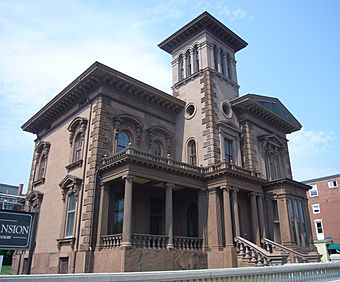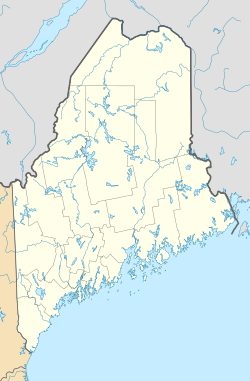Victoria Mansion facts for kids
|
Morse-Libby House
|
|
|
U.S. Historic district
Contributing property |
|

Victoria Mansion
|
|
| Location | 109 Danforth Street, Portland, Maine, United States |
|---|---|
| Area | less than one acre |
| Built | 1858-1860 |
| Architect | Henry Austin |
| Architectural style | Italianate |
| Part of | Spring Street Historic District (ID70000043) |
| NRHP reference No. | 70000074 |
Quick facts for kids Significant dates |
|
| Added to NRHP | May 19, 1970 |
| Designated NHL | December 30, 1970 |
| Designated CP | April 3, 1970 |
The Victoria Mansion, also called the Morse-Libby House, is a really old and fancy house in downtown Portland, Maine, United States. It's famous for its beautiful brownstone outside and amazing decorations inside. The house shows what rich life was like in America way back in the 1800s. It became a National Historic Landmark in 1971 because it's such a great example of an Italianate style mansion that has been kept in excellent condition.
Contents
Building a Dream Home
Who Built It?
This grand brownstone house was finished in 1860. It was built as a summer home for a rich hotel owner named Ruggles Sylvester Morse. Mr. Morse had left Maine to make his money running hotels in big cities like New York, Boston, and New Orleans.
Design and Style
The house was designed by an architect named Henry Austin from New Haven. It has a unique, uneven shape with a tall four-story tower. You can also see wide roof edges, porches (called verandas), and fancy windows.
Inside, the walls have amazing paintings called frescoes and trompe-l'œil (which means "trick the eye"). These paintings make flat walls look like they have depth or objects sticking out. An artist named Giuseppe Guidicini created these cool decorations.
Special Features Inside
The Victoria Mansion is known as one of the best and most original examples of a large Italianate house in the United States. A designer named Gustave Herter created the interiors. This house is his earliest known work that is still completely intact today.
Thanks to gifts from the Libby family, almost all of the original items are still in the house. This includes furniture made by Herter, detailed wall paintings, artworks, carpets, and even the old gas lights. There's also stained glass, fancy dishes, silver, and glassware.
The house has some really cool features. For example, there are two sinks in the guest bedroom upstairs. There's also a special Turkish smoking room, which was one of the first places in the U.S. to use Islamic architecture style. You can also see beautiful carved marble fireplaces and a "flying staircase" that seems to float.
Old-School Technology
When Mr. Morse designed the house, he added features from his luxury hotels. This included a large, tall entrance and wall-to-wall carpets. The house also had some of the newest technology of its time. It had central heating, gas lighting, and even hot and cold running water! There was also a system to call servants.
The water system was very clever for its time. Rainwater was collected from the tower and third floor gutters. It then flowed through pipes to all the rooms. There were separate pipes for hot water (heated by coal) and cold water.
Who Lived Here?
Ruggles Sylvester Morse lived in the house until he passed away in 1893. About a year later, his wife sold the house and everything inside to Joseph Ralph Libby. He was a merchant and owned a department store in Portland. The Libby family lived in the house for over 30 years, until 1928. They didn't change much, except for repainting one green room white. Sadly, this change couldn't be undone when the house became a museum.
Becoming a Museum
Saving the Mansion
The last of the Libby family moved out of the house in 1928. A year later, the Great Depression started, which was a very tough economic time. Because of unpaid taxes, the house was taken over by the city in 1939, after a big flood in Portland in 1938. The house was empty and its future was uncertain.
There were even plans for an oil company to buy the old house and tear it down to build a gas station! But a man named William H. Holmes stepped in and bought the house. He wanted to save it and turn it into a museum.
Visiting Today
In 1941, Holmes opened the house as the Victoria Mansion. He named it after Britain's Queen Victoria. The mansion was later added to the National Historic Register. Today, it is still open as a museum, welcoming visitors to explore its history and beauty.
See also



